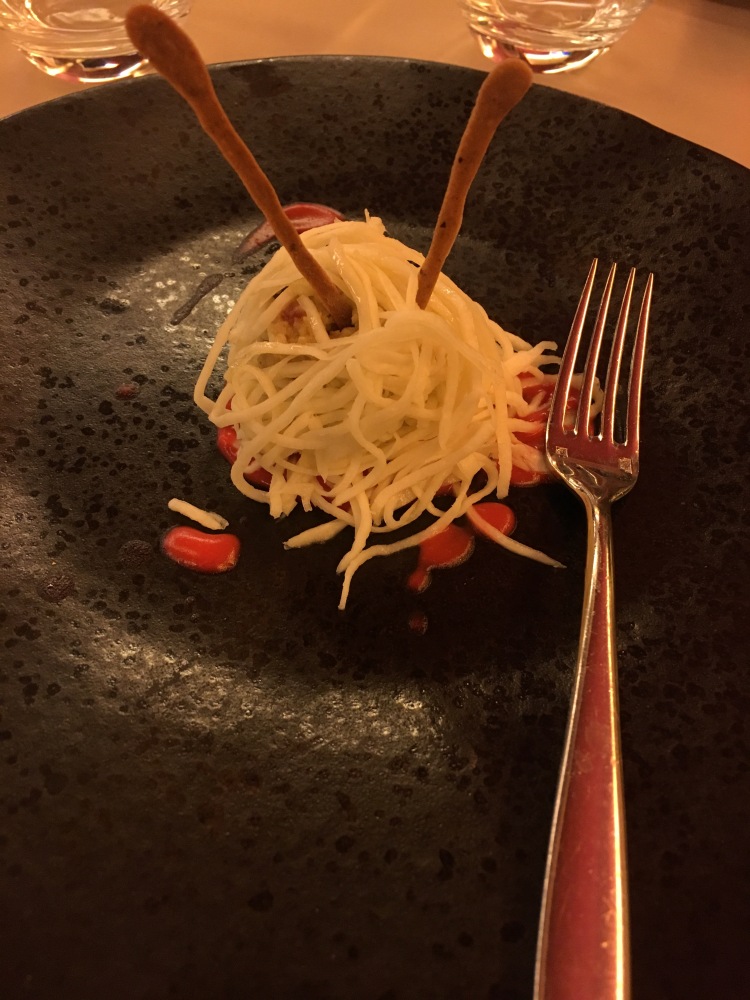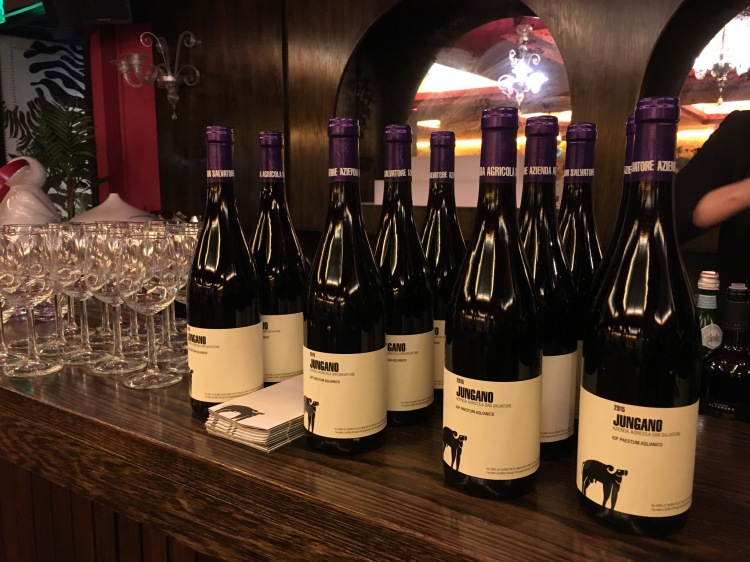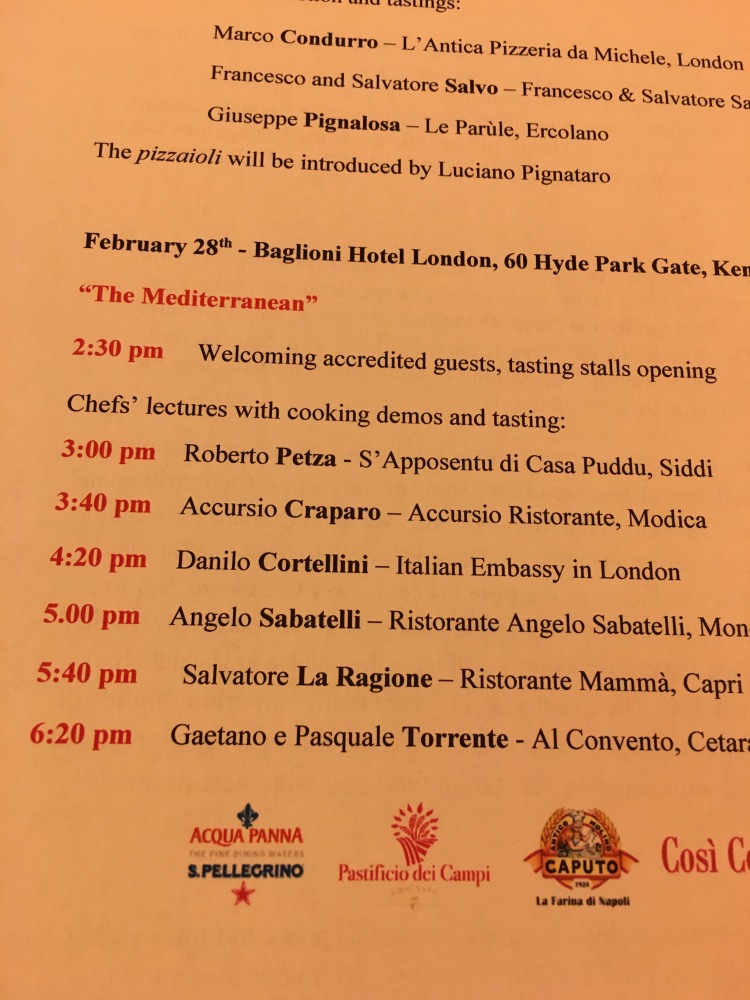The ‘Strada della Mozzarella’ road show arrived in London this week. An amazing event featuring six different chefs from all over Southern Italy. The road show includes London, Milan, Paestum and New York. The idea is to promote the finest foods and flavours of ‘the south’ including the regions of Campania, Puglia, Sicily and Sardinia. The main sponsor of the event is the Mozzarella di Bufala Consorzio. This is the marketing agency for Mozzarella cheese. So many (but not all) of the dishes featured Mozzarella cheese used in original and inventive ways.
This was a uniquely Italian event where pasta makers, olive oil producers, chefs and the great and the good of the foodie world came together to demonstrate the fantastic quality of Southern Italian food. The whole event was conducted in an enthusiastic and endearing style. A range of delicious red wines from Puglia and Campania lined the bar. Still and sparkling water, Acqua Panna and San Pellegrino of course, in abundance. Within minutes I’d discovered that a really very drinkable red wine is produced just minutes from Paestum. Paestum is a wonderful archaeological site of Greek temples, located just south of the Amalfi peninsula. In the days of the Grand Tour people thought the temples at Paestum were Roman. In fact, they were built by the Greeks around 350 BC and are in a classical Greek style, very, very similar to the Parthenon in Athens. The fertile agricultural land around Paestum is ideal for the rearing of buffalo cattle, introduced to this area by either the Normans or the Arabs – locals are not certain. Today these herds produce the finest quality milk which is made into the delicious and flavourful Mozzarella cheese.
THE CHEFS – Many of the chefs present at the event have worked and trained all over the globe. First up was Roberto Petza from Sardinia. He opened a restaurant in a very small village in Sardinia, six years ago. He now has one Michelin star and a Cookery School. His focus is on the finest and freshest local produce. Each morning chefs from the kitchen forage in the fields and hills nearby searching for wild herbs; asparagus, fennel, chicory and asparagus. These young and tender leaves are cooked very gently with garlic and olive oil. He creates a crispy pasta from mozzarella and then fills the pasta with the fresh herbs. Three times a week he heads down to Cagliari, on the coast, to visit the fish market. He carefully selects the finest prawns, shrimps and fish for his restaurant. Last year, or the year before he produced his own organic olive oil from his olive trees. Recently he opened a pizzeria nearby. For Roberto, Italian food is all about simplicity and quality of ingredients. He is serious, dedicated and focused entirely on quality and taste.
The next chef was Accursio Craparo, who lives and works in Sicily. Accursio is based in the charming Baroque town of Modica. One of the prettiest small towns in the south-east of Sicily. The cuisine of Sicily is quite unique, it is a fusion of east and west, north and south. Over the centuries Sicily was occupied by the Greeks, Phoenicians (from North Africa), Romans and Arabs. Later the Norman Princes from France took control and created the Kingdom of Sicily. Then Sicily became a colony of Spain, until finally becoming part of a unified Italy in the 19th century. No region of the Mediterranean has experienced a more colourful and varied history than Sicily. Accursio cooked for us a ‘Gomito di Mozzarella’ using Mozzarella cheese, carefully dried and then cooked to create a spaghetti-like texture of long, delicate tendrils. Inside there was cous cous, introducing a North African flavour to a traditionally Sicilian dish. The result was unusual and quite delicious.

Next we were entertained by Danilo Cortellini, chef at the Italian Embassy in London. This man is an entertainer, he speaks great english, loves being at the front of the crowd and was thoroughly endearing. He described himself as a ‘private chef’ producing food for business lunches, grand dinners and small private meetings as required. He has appeared on Masterchef (The Professionals) on British TV. His contribution to the event was a mozzarella and fish dish served with wild asparagus, that had been delivered earlier in the day. The asparagus was the first of the season – don’t forget the date was only 28th February. That’s pretty early for asparagus. In fact the Italians generally do not approve of mozzarella served with fish – ever! So the reaction from the audience to Danilo’s dish was fairly mixed. In fact the mozzarella with mackerel, an oily fish, gently seared on top looked good and tasted fine. I particularly liked the wild asparagus, which for me was the highlight of the dish. In fact Danilo has just produced his first recipe book and is a master of self publicity, always in a very charming way!
AL DENTE PASTA
At any event where Italian food is being served and discussed, sooner or later the question of how to cook pasta will be brought up. The Italians, generally, prefer ‘al dente’ pasta. This means that when the pasta is in the mouth there is a resistance on the teeth. Literally ‘al dente’ to the teeth. This means that the pasta must be chewed before swallowing. The chewing process allows the flavour of the pasta to develop fully in the mouth before swallowing. ‘Al dente’ pasta is considered to be perfectly cooked.
Outside Italy there is a tendency to overcook pasta and to serve it soft. This is frowned upon amongst the Italians. The head of ‘Pastifico dei Campi’ one of the highest quality pasta producers in Italy, made an interesting point. He observed that cooking time for dry pasta is usually about 8 minutes. So if you cook the pasta for 10 minutes you are over cooking it by 20%. So a relatively short period of overcooking is easily done. It is much better to slightly undercook the pasta, perhaps for 6 minutes and then to let it sit for a minute or two before serving. After all the hot pasta will continue to cook for a short period even when it has left the pan. Giuseppe d’Aquino made the same point when he was cooking in London back in October last year.
MONOPOLI, PUGLIA
The next chef of the afternoon was Angelo Sabatelli of Ristorante Angelo Sabatelli located in the town of Monopoli. To ring the changes Angelo had been asked to produce a dish using olives, the most important culinary product of Puglia. Now this is where it became really interesting. Highly original and inventive, Angelo took some whole black olives, de-stoned them and blanched them. Then he served them as a dessert with blackcurrants. The dish had a crispy, toasted, pasta garnish. The olives and blackcurrants were surprisingly good. The combination of flavours reminded me of strawberries with balsamic vinegar. A curious but actually very palatable dessert! As an after thought Angelo described to the audience how he also prepares a 30 hour ragu sauce for his restaurant. This is a meat based sauce that is allowed to cook very gently for a day and a half. This lengthy cooking process creates the tenderest and most flavourful of sauces. Next time I am in Monopoli this is the dish I am trying!
POMODORINI DI CORBARA – Around the room food producers had set up small ‘tasting stations’ where you could try mozzarella, olive oils and tomatoes. The ‘pomodorini di Corbara’ caught my eye. These tomatoes are grown on the slopes of Monti Lattari just south of Naples. The region is Campania. Here the combination of salty air from the sea and the rich mineral soils of this volcanic area produce a delicious, almost sweet tomato. Bottled at the point of picking these tomatoes are preserved in water and salt. Many southern Italian chefs working in Northern Italy insist on sourcing their tomatoes from Southern Italy. They regard them as being bottled with the sunshine of Southern Italy. The chef from the island of Capri, Salvatore La Ragione, was impassioned when talking about the quality of the ingredients needed to create even the simplest dish. Pasta con pomodorini is a perfect example. One of the simplest dishes, and yet to prepare it and serve it the finest and ripest small tomatoes (pomodorini) are required.
I was fortunate to meet one of the ‘pomodorini’ producers. They promote themselves as ‘Sapori di Corbara’ which means the ‘Flavours of Corbara’. Local pomodorini tomatoes are their main focus. Gabriella Acciaio explained to me about the unique geographical conditions that allow them to harvest the sweetest and tenderest tomatoes from their volcanic hillside.Corbara pomodori are grown in Amalfi and the slopes of the Monti Lattari hills. These tomatoes are very sweet, as they grow they absorb the flavours of the winds (sea air) and the minerals of the soil in this highly volcanic area. It is very important to cook these pomodorini very gently. Gabriella was charming and enthusiastic. I made a mental note to visit the farm next time I’m in Campania.
Lastly came the father and son team from Cetara on the Amalfi Coast. Gaetano and Pasquale Torrente. The father was a natural speaker. Here at a London event he described his horror at experiencing British style fish and chips many years ago. He decided to focus on ‘frittura’ fried foods. His goal was to produce light and delicious fried fish and vegetables. He and his son have been hugely successful. They use only the lightest of oils. The sample frittura we tried were not greasy at all. In fact it was like enjoying a ‘tempura’ style battered vegetable and fish selection. Truly delicious.
THE WINES – a range of Southern Italian wines were available. My favourites are the red from Paestum from the Azienda San Salvatore and the Primitivo, a rounded and delicious red from Puglia and Basilicata.
COMPLIMENTI – to ‘Le Strade della Mozzarella’ – What a great event. The afternoon was a true journey into the food and wine of Southern Italy. The sunshine that promotes the growth of the vines, olive trees and tomato plants provides the basis for a Mediterranean diet that is admired all over the world. As I emerged into the cold February air of a London evening I had to blink several times and bring myself back to reality. Until the cold air hit me unexpectedly I actually thought I was stepping out into an Italian sunset with the golden globe of the sun sinking gently behind the distinctive rocky cliffs of the island of Capri and the Bay of Naples.


Notes:
- LSDM – is an international event ‘Le Strade della Mozzarella’ aimed at promoting Italian Mozzarella cheese and other top quality Italian food ingredients.
- Roberto Petza is an amazing chef, his restaurant is Ristorante S’Apposentu Di Casa Puddu, Sardinia. He is a really original and inventive chef. A name to look out for in the future: Roberto Petza
- There is a wonderful web site www.greatitalianchefs.com it is well worth a look.
- Paestum Wines are produced by Azienda San Salvatore 1988 based a few miles from the Greek Temples at Paestum. www.sansalvatore1988.it
- Giuseppe d’Aquino is executive Chef at Villa Cordevigo (Verona) he is from Naples and is passionate about using Southern Italian produce: Italian food, passion and flavour I have written about Giuseppe and Villa Cordevigo on several occasions.
- Chef Accursio Craparo cooks in Modica, Sicily. It is a beautiful part of the island. Here’s an article I wrote about Sicily – A day in the Baroque towns of the island
- Danilo Cortellini is the Head Chef at the Italian Embassy, London he has recently written his first cook book. www.danilocortellini.com
- Sapori di Corbara specialise in growing and preserving ‘pomodorini’ tomatoes of the finest quality. www.isaporidicorbara.it
- With thanks to ‘Great Italian Chefs’ for inviting me to this energising event.
- The ‘Educated Traveller’ writes regularly about Italian food and wine. You may enjoy recent articles about: Truffle Hunting near Bologna
- Or perhaps an article about ‘The Purple Artichoke of Sant’Erasmo’
- 02 March 2017
- 07 March 2017







Ah, once again you’ve taken me back to Italy, Janet! I can’t wait to get back there and taste some of the dishes you have written so temptingly about!
LikeLiked by 1 person